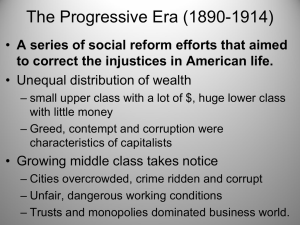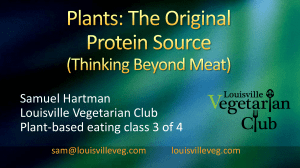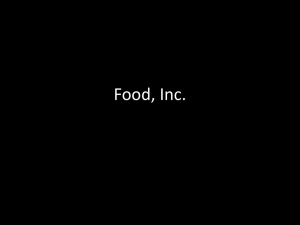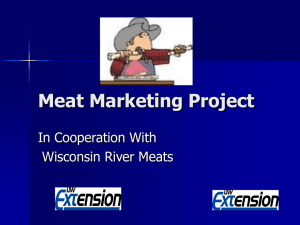The True Cost of Meat
advertisement
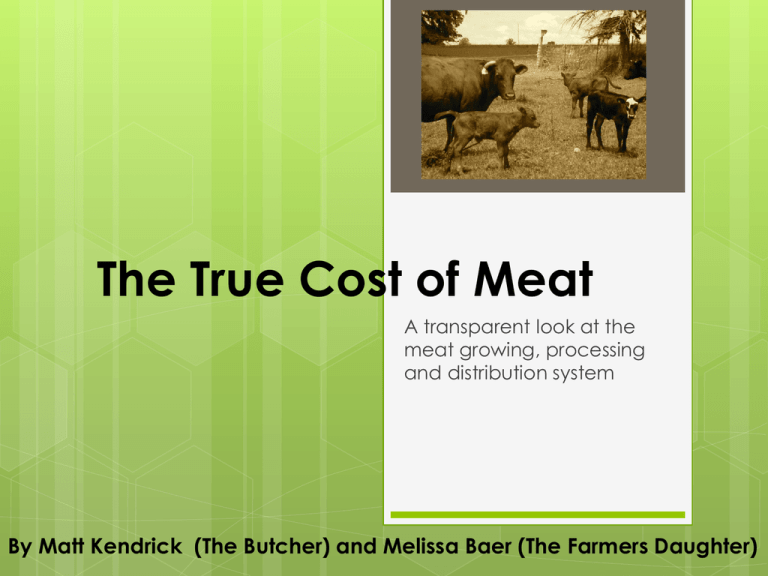
The True Cost of Meat A transparent look at the meat growing, processing and distribution system By Matt Kendrick (The Butcher) and Melissa Baer (The Farmers Daughter) Who We are & Why We’re here Matt Kendrick – Manager & Head Butcher at The Bauer Butcher, trained Chef, committed to supporting small Ontario Farmers focused on sustainability Melissa Baer- Certified Organic Farmer’s Daughter, Food and Health Advocate, Sell Grass Fed Organic Beef to people Twitter: Matt - @bauerbutcher Melissa - @afarmdaughter Objectives To leave you with a clear understanding of the different kinds of meat Have you clearer on your own priorities when it comes to meat Destroy any myths about meat and pricing Your Worksheet This if for you to take home Fill out as many spaces on it as possible as accurately as possible You may need a calculator (phone) to do it Your Total Calculations Total Meat consumption rate= Household size X # meat meals Total Meat Spending Rate = Total consumption X 8.00 X 0.3lbs Start at the Beginning Defining (the farm) various types of meat Inputs to raising these different types of meat Why and how farming techniques affect your health Defining the Labels Conventional Naturally Raised Organic Grass Fed Free Range Factory Farmed Local Conventional Typically means using regular feed mill feed Not organic Likely GMO Likely antibiotics and hormones and vaccines are utilized Is not labeled as such – often is the default when no other label is present These are the farms you’ll see scattered across the country side Can sometimes mean Feedlot (or factory farmed) conditions Naturally Raised ZERO standards (what is natural to one person is not natural to another) Can mean simply that they are outside sometimes Can mean that they don’t have as MANY antibiotics, or maybe none at all Can mean a variety of things, none of which are the same from farm to farm Organic A third party inspection agency has come to inspect the farm, and has determined they are adhering to standards There are various standards across inspection agencies and jurisdictions CFIA – lowering standards but governing Band wagon jumpers – beware! DOES NOT require farmers to NOT vaccinate no medication (Drugs/hormones) No pesticides Animals must have access to outside Grass Fed No standardization Can mean they got some or they were entirely grass fed Grass Finished – means they were ALSO Finished on grass (usually farmers will use corn or grain to finish for better fat marbling) Usually means they have access to outside USDA has standards but NOT in Canada (CFIA) Free Range Not Standardized Is supposed to mean they have free access to pasture land May just be Free Run – cage/stall free and can freely roam about May not have any health benefits depending on the quality of the soil, or if they are still fed in the barn (corn and grain etc) Factory Farmed Typically refers to CAFO’s (confined Animal Feeding Operations) Feedlots, caged hen laying operations, sow barns, etc Generally is for the purpose of high volume, is likely feeding corn/high energy food for quick production and weight gain Generally uses stock that has been genetically manipulated for production Will use high amounts of medication due to sickness (Vaccinations, hormones, drugs etc) Local Local does NOT mean healthy Local can mean factory farmed still Local can still be GMO, Vaccinated, drug and hormone filled Local only refers to the proximity in which it is grown to its final destination (your plate) What’s important to ME? Organic Local Humanely raised GMOfree Vaccine free Antibiotic free Naturally raised Drug free toxicity sustainable micro nutrients Grass Fed Grass Finished Socially conscious Environment List in terms of priority List each of your priorities in order of importance By understanding what is your TOP priority this will help to guide your purchases Time and Inputs Conventional has corn – subsidized Works on volumes Grass fed – takes more time to get them to market (and more land - $$) Organic –depends on type of feed (certification and attention to detail) Cow Calf operations – low meds required, more attention to detail Processing Large slaughter houses (work on volumes), have no ability to identify Have no humane policies No traceability Smaller abattoirs for local meat – sparse Cost of transport for small batches Cost of land Cost of hay (drought, weather dependent) Micro nutrient density Soil stewardship – wont be around if we dont Price At the Farm gate (wholesale) Lowest – Conventional Middle – Naturally Raised Higher- Organic Highest – Organic Grass fed The NEXT step – Butcher Retail Cost of Grass fed Cost of organic Cost of naturally raised Cost of conventional Meat – Retail Perspective Purchasing, loss and costs, rent, salaries etc Planning – when buying meat Buying better cuts: need less when buying better: article (maintains muscle mass, etc) get creative with cuts Beef Yield (i.e. true COG) Weight Price /lb Cost Billed (hot) 284 $4.25 $1207 Received 270 $4.47 $1207 Yield (retail) 202 $5.98 $1207 *as a whole animal butcher we lose up to %30 of what we pay for by the time the product is ready for sale Retail Meat – The Numbers Total Sales $50 000 Cost of Good $30 000 60% Fixed Costs (rent, insurance, etc) $2 500 5% Variable Costs (labour, packaging, supplies, delivery, etc. $13 500 27% Total Costs $46 000 92% Net profit $4 000 8% Buying Meat – Plan Ahead When buying at a butcher try to go every 2-3 days Plan meals to include leftovers (lunch, another dinner, etc) Consider buying whole pieces (i.e. a whole chicken can yield 3 meals or more) Cook more stews, stir fry, salads where the average portion size tends to be smaller Buying Sustainably The 3 most popular beef cuts account for only 15% of the yield Find different cuts to try(Flat Iron, Hanger, Flank, Round) Challenge yourself to try recipes for new cuts every 2 weeks. Talk to your butcher and ask questions! Other Hidden Costs Health costs Long term Soil costs long term Fossil fuels cost long term Need less when buying quality “It may cost less in dollars right now because of a falsified economic system, but when it takes 2 units of energy to produce 1 unit –we’re missing something” “you pay for your health at the grocery store or the hospital” (since we have free health care, it would be in quality of life) Where to get each type of meat Conventional- Large Grocery Chains, Costco, Walmart Naturally Raised – Butcher shops, farmers markets, direct from Farmers Grass Fed and/or Organic- Bauer Butcher, specialty meat shops, direct from farmers Meat Industry Myth’s & Facts Myth or Fact Loblaws “Free from” program is an Organic program? Myth or Fact Drug Free meat is entirely drug free Myth or Fact Local is basically the same as Organic Myth or Fact Eating better is A LOT more expensive Myth or Fact If I eat conventionally raised beef, its not REALLY that bad for me Thank you Any Questions? We hope you have gained some insight into meat, and how you can improve your grocery shopping

